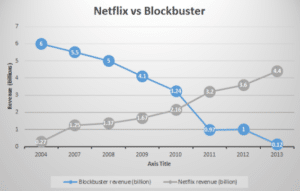It is a cautionary tale that we are all too familiar with: the small upstart, Netflix, disrupts the much larger and better resourced Blockbuster. What in the world does this have to development? Everything, it seems.
In 2000, when Netflix was still a small and fledgling company, it offered itself to Blockbuster, the world’s largest video, DVD, and game rental company for $50 million. Blockbuster passed. In retrospect, it is easy to laugh at this miscalculation, but consider that compared to Blockbuster, Netflix was barely a blip on the radar. Netflix was a very tiny company with mounting losses, and one with a very uncertain future. Blockbuster, on the other hand, was a true blockbuster in every sense of the word. With revenues of more than $5 billion in 2000, and $800 million collected in late fees alone, Blockbuster seemed unstoppable. Understandably, Netflix was inconsequential.
Today, Netflix is worth more than $60 billion. $60 billion!!!! Blockbuster filed for bankruptcy in 2010. What happened to the behemoth which, at one point, managed more than 9,000 stores and employed over 60,000 people? It turns out that Blockbuster and Netflix had fundamentally different strategies. Blockbuster’s was resource-based while Netflix’s was process-based. It was this difference in strategies that caused the demise of Blockbuster and the meteoric rise of Netflix. And it is precisely Netflix’s strategy that development organizations should emulate.
An organization’s capabilities
Every organization has three sets of factors in its capabilities: resources, processes, and priorities. Resources are the most tangible; they include people, equipment, technology, product designs, brands, intellectual property, cash, etc.
Organizations create value as they transform inputs of resources into products and services of greater worth. Processes are the patterns of interaction, coordination, communication, and decision making through which organizations accomplish these transformations. An organization’s processes include the ways that products are developed and made and the methods by which procurement, market research, budgeting, employee development, and resource allocation are accomplished.
Over time, an organization’s priorities emerge and then coalesce as a result of the interactions and amalgamation of all the organization’s processes. The interplay between resources and processes dictate an organization’s priorities.
Resources vs. Processes; Blockbuster vs. Netflix
Fundamental to Blockbuster’s business model was a tightly knit resource strategy that was difficult to overcome. For example, in order for Blockbuster to grow, the company needed to open and manage as many stores as the market allowed. This necessitated the addition of real-estate, the employment of thousands of staff, and the acquisition and management of more and more movie titles. Many may consider this strategy simplistic and archaic, but not so fast.
At its peak, Blockbuster grossed more than $6 billion. Fewer than .05% of companies reach annual revenue of $100 million. Contrary to popular belief, Blockbuster was a money minting machine whose resource-based strategy had done extremely well. Netflix was different. While Netflix initially had to manage a plethora of resources (DVD titles, operational centers, warehouse staff and equipment, and so on), the company’s business model was, and still is, fundamentally process-based. And core to a process-based strategy is innovation—creating practical solutions to real problems.
In 1997, Reed Hastings and Marc Randolph co-founded Netflix as a DVD rental company. As opposed to building thousands of stores all across the country, the company mailed DVDs to its customers. At the onset, Netflix looked like a less efficient and under-resourced version of Blockbuster. But the underlying strategy was different. Instead of figuring out how to acquire as many titles as possible and manage as many warehouses as its investors would allow, Netflix focused on the process by which it delivered its product to its customers, you and me.
NETFLIX AND BLOCKBUSTER REVENUES, 2004 to 2013
Source: http://www.chiefinnovator.com/structure-methods/blockbuster-busted-part-1-s-curve-analysis
And so, the company innovated. Every chance it got, Netflix changed the process by which it delivered movies to us. It first mailed DVDs. And then it began leveraging the internet. And now, the company develops original content—Netflix makes its own movies and TV shows. Can you imagine Blockbuster making TV shows? Or movies for that matter? Difficult as it may be, organizations pursuing process-based strategies are willing to change the fundamentals of their business models in order to serve their customers’ Jobs to Be Done.
Development organizations should employ process-based strategies
Perhaps no industry exemplifies a resource-based strategy as much as the development industry. Since 1960, official development assistance to low and middle-income countries has totaled more than $4.3 trillion. This has resulted in pushing many schools, toilets, and water-wells into some of the poorest communities in the world. This is understandable because poverty almost always shows itself as a lack of resources, such as schools, water, toilets, roads, and so on. But as I wrote in this piece, many of those investments are not having the desired outcome. Much like the Blockbuster strategy, they may work for a while, but ultimately, they are unsustainable.
Instead, development organizations should employ a process-based strategy that is steeped in innovation. This means that they should work with local entrepreneurs to develop practical solutions to real problems that people in low-income countries face. These solutions will ultimately create a market that pulls in the necessary resources, such as schools, clinics, roads, and other important things these communities lack.
Sudanese billionaire, Mo Ibrahim’s Celtel is a perfect example of this kind of thinking. In 1998, Mr. Ibrahim decided to build a telecommunications network (telco) in some of the poorest countries in Africa. Many thought he was crazy because those regions did not have the requisite resources for a telco to flourish. But Mr. Ibrahim was unfazed as he focused on developing the right processes that enabled him to best utilize his resources so that he could deliver “talk time” to his millions of customers. For example, he changed the process by which customers purchased “talk time” by introducing recharge cards to the market. This differed greatly from the existing model at the time where customers needed to go to a store to pay their bills. In seven short years, he sold his company for $3.4 billion. Today, the telecommunications industry in Africa is worth more than $65 billion and employs tens of thousands of people.
Resources are important. But processes that transform resources to solutions of greater value are more important.




